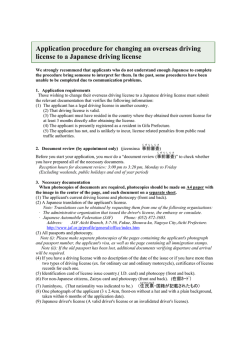
高齢者の口腔ケア
Circ J 2007; 71: 1800 – 1804 Assessment of Fitness to Drive and Cardiovascular Diseases at the Spanish Medical Traffic Centres F. Javier Álvarez, PhD, MD; Inmaculada Fierro, MD; África Vicondoa, MD*; Marta Ozcoidi, PhD, MD**; Ma Trinidad Gómez-Talegón, PhD, MD Background There is an increased risk of automobile accidents in patients with some cardiovascular disorders and licensing authorities have imposed certain restrictions on such persons. Experience assessing fitness to drive among drivers with cardiovascular disorders, and the relevance of other associated medical conditions among drivers assessed as unfit, are reported here. Methods and Results The study included 5,234 drivers attending 2 Spanish Medical Driver Test Centres to assess their fitness to drive. Information regarding sociodemographic aspects, driving patterns, medical conditions, medication use and alcohol consumption patterns was recorded: 11.6% of the drivers had a cardiovascular disorder that potentially impaired fitness to drive, 82.5% were found fit to drive, 15.9% were fit to drive with restrictions and 1.6% were unfit. The 10 unfit patients with cardiovascular disorders were primarily considered unfit because of their associated ophthalmologic and medical comorbidities, but the cardiovascular disorders were a contributing factor. Conclusion Most (98.4%) drivers with cardiovascular disorders will be completely fit to drive or fit to drive with restrictions. There is a need for a personalized evaluation of fitness to drive for each driver/patient, taking into account such aspects as the associated pathology, the taking of medicinal drugs and alcohol consumption. (Circ J 2007; 71: 1800 – 1804) Key Words: Accidents; Automobile driver examination; Cardiovascular diseases; Traffic n developed countries, licensing authorities have imposed certain restrictions or conditions on the concession of driving licenses to persons with particular medical conditions.1–7 Within the European Union (EU), Annex III of the EU Directive 91/439/EEC establishes the minimum requirements concerning physical and mental fitness to drive a motor vehicle.8 Although this Directive is obligatory for all EU member states, there are marked differences in its implementation among the various countries.9–11 Spain is the only EU member state that carries out an obligatory fitness test for driving of all drivers at certain time intervals, depending on age and licence type.11 Here we present the results for the assessment of fitness to drive in 5,234 drivers. The aim of the study was to assess both fitness to drive among drivers suffering from cardiovascular disorders and the relevance of other associated medical conditions among those with cardiovascular disorders who were assessed as unfit to drive. I Methods Fitness to Drive Assessment Fitness to drive in Spain is evaluated in Medical Driving Test Centres by an ophthalmologist, a psychologist and a (Received February 15, 2007; revised manuscript received May 22, 2007; accepted July 25, 2007) Faculty of Medicine, University of Valladolid, Valladolid, *Centro de Reconocimiento de Conductores del Colegio Oficial de Médicos de Navarra, Pamplona and **Gabinete Psicotécnico de Huesca, Huesca, Spain Mailing address: F. Javier Álvarez, PhD, MD, Faculty of Medicine, University of Valladolid, 470055 Valladolid, Spain. E-mail: alvarez @med.uva.es general practitioner who follow EU7 and Spanish regulations.11 The 3 professionals reach a decision concerning fitness to drive. The purpose is to check that the driver complies with the minimum requisites to drive safely. The stringency of the requisites will depend on the type of licence requested (professional or not). Drivers who do not comply with the necessary conditions to drive safely are declared “unfit”; those who can drive, but with certain restrictions (eg, changes to the vehicle, speed limits or reduced periods of licence validity) are declared “fit to drive with restrictions”; and those found to comply with the necessary conditions are declared “fit”. With respect to the cardiovascular system, a driving licence cannot be given to or renewed for those people suffering from several disorders,8,11 as summarized in Table 1. The criteria for evaluating fitness to drive in patients with certain cardiovascular disorders are made on the basis of the functional criteria of the New York Heart Association and on the risk of suffering either sudden loss of consciousness or sudden death (both of which are frequently related to cardiovascular problems).12 The following psychomotor performance tests (psychotechnical set LND-100©, ASDE, Valencia, Spain), under the supervision of the psychologist, are carried out by all drivers according to legal regulations:11 speed of anticipation and bimanual coordination, as well as multiple reaction times for professional drivers. The result is a valid or invalid test.11 The auditory capacity is evaluated by tonal audiometry in a soundproof cabin. Subjects A prospective study was designed that included drivers attending 2 Medical Driving Test Centres to obtain a Circulation Journal Vol.71, November 2007 Cardiovascular Diseases and Fitness to Drive 1801 Table 1 Cardiovascular Disorders That Could Impair Fitness to Drive According to Spanish6 and European Union Regulations Cardiovascular disorder Car driver: criteria for obtaining a driver license Professional drivers: criteria for obtaining a driver license Heart failure Compensated, without syncope; NYHA class I/II Compensated, without syncope; NYHA class I and with EF >45% Potentially syncopal or severe arrhythmia 6 months without syncope, except where specialist’s report indicates curative therapy; NYHA class I/II 2 years without syncope, except where report indicates curative therapy; NYHA class I Transient ventricular tachycardia Positive specialist’s report and acceptable ventricular functioning No recurrence for 6 months; no recurrence on Holter and EF >40% Pacemaker May drive 1 month after implant with favourable report from cardiologist May drive 3 months implant with favourable report from cardiologist Implantable cardioverter defibrillator Requires period of 6 months without discharge after implant, EF >30%, absence of repeated discharges and favourable report of cardiologist Not allowed Heart valve prothesis May drive 3 months after implant with favourable report from cardiologist May drive 3 months after implant with favourable report from cardiologist Ischemic cardiopathy: stable angina Allowed in NYHA class I and II (with favourable report by cardiologist) Allowed in NYHA class I Myocardial infarction May drive after 3 months May drive after 3 months, with negative ergometry and favourable report by cardiologist Revascularization through by-pass or angioplasty May drive 1 month after intervention with favourable report by cardiologist May drive after 3 months, asymptomatic, with negative ergometry and favourable report by cardiologist Arterial hypertension There must be no signs of organic effect or uncompensated blood pressure values that might mean a risk to road safety There must be no signs of organic effect or uncompensated blood pressure values that might mean a risk to road safety Aortic dissection and aneurysm Driving not allowed except following effective surgical repair Driving not allowed except following effective surgical repair Peripheral arterial disease Association with ischemic cardiopathy must be evaluated Association with ischemic cardiopathy must be evaluated Venous diseases There must be no profound venous thrombosis There must be no voluminous varicose veins in the lower limbs NYHA, New York Heart Association; EF, ejection fraction. driving licence, or to renew it. The overall results from the study can be seen at the IMMORTAL home web page (http://www.immortal.or.at).13 The study was approved by the Clinical Research Ethics Committee at the Valladolid Faculty of Medicine. Of 5,324 drivers contacted, 90 did not want to participate, so the study included 5,234 drivers: 3,741 males (71.5%) and 1,493 females (28.5%). Drivers’ ages ranged from 14 to 98 years of age. The average age was 44.21±16.46 (mean ± SD), greater in males (46.13±17.15) than in females (39.40±13.56; t=14.973, p<0.001). The sample distribution by age group was as follows: <25 years: 616; 25–34 years: 1,107; 35–44 years: 1,013; 45–54 years: 1,126; 55–64 years: 642; 65–74 years: 533; ≥75 years: 197. Information Recorded Any medical condition suffered by any driver, either acute or chronic, was recorded. For the present analysis we considered only chronic disorders (>1 month in duration) for disorders others than of the cardiovascular system. Diseases were recorded according to ICD-10. For the cases of drivers with disorders of the cardiovascular system, special attention was paid to those mentioned in the Spanish regulations11 (Table 1). The medication taken, the daily doses, the duration of treatment, and the categorization of medicinal products on driving performance was recorded:14 (i) category 1: no or Circulation Journal Vol.71, November 2007 negligible influence; (ii) category 2: minor or moderate influence; (iii) category 3: major influence on driving. For the present study, as well as medical conditions, only chronic medication (>1 month in duration) was analyzed. Patterns of alcohol intake were assessed: frequency of drinking and quantity of alcohol intake. Alcohol intake was expressed in standard drink units (SDU). Drinkers were classified based on their consumption level as follows: Low consumption: men ≤21 units/week and women ≤14 units/week; moderate consumption: men 22–50 units/week and women 15–35 units/week; high consumption: men >50 units/week and women >35 units/week. A Spanish SDU is equivalent to 10 g of pure alcohol. Information was recorded regarding the valuation by the general practitioner, the ophthalmologist and psychologist in their respective fields: fit, fit to drive with restrictions, or unfit. Statistical Analysis Statistical analyses were performed using SPSS 12.0 version (Chicago, IL, USA). Chi-square and t-test were applied when appropriate. P values ≤0.5 were considered statistically significant. Results For the total sample (n=5,234), 82.7% of the drivers Car/3,000 Car/1,000 Car/2,000 Car/<1,000 Car/10,000 Car/1,000 Car/5,000 Car/10,000 Car/1,000 B/20,00 77/M/retired 78/M/retired 79/M/retired 70/M/retired 65/M/retired 53/F/active 72/M/retired 30/F/active 69/M/retired 81/M/retired SDU, standard drink unit. Driver licence/ annual km driven Age (years)/gender/ activity status Atenolol + cortalidone, Aceclophenac Insuline, Enalapril, Glucosamine sulfate Nifedipine, Sabutamol, Ácetylsalicylic acid Isosorbide mononitrate, Ácetylsalicylic acid, Colchicine Paroxetine, Risperidone, Ácetylsalicylic acid, Hidrosmin, Calcium, Enalapril Captopril, Ipratropium bromide, Salbutamol, Continuous positive airway pressure Ácetylsalicylic acid, Prevastatin, Propanolol Acenocoumarol, Enalapril, Digoxin Nifedipine Enalapril, Ácetylsalicylic acid Medication (>1 month) Abstainer Abstainer Abstainer Once weekly 2 SDU/week Daily 15 SDU/week Daily 14 SDU/week Daily 14 SDU/week Daily 21 SDU/week Daily 21 SDU/week Once weekly 1 SDU/week Alcohol consumption Table 2 Patients With Cardiovascular Pathology and Considered Unfit to Drive Hypertension, Bilateral hip protheses Hypertension, Diabetes type II Hypertension, Heart failure, Respiratory, Insufficiency Angina, Hyperuricemia Hypertension, Depression, Osteoporosis, Venous, Insufficiency Hypertension, Respiratory, Insufficiency Stable angina, Hyperlipidemia Hypertension, Arrhythmia (auricular fibrillation), Senile tremor, Slow movements, Cervical rigidity Hypertension Hypertension, Cervical rigidity, Heart failure Medical condition Fit Fit to drive with restrictions, Diabetes Fit Fit Unfit, Depression Unfit, Dyspnea because of respiratory insufficiency Fit Unfit, Neurological deterioration Fit Unfit, Decrease in cervical mobility Medical evaluation Fit Fit Fit Fit Fit Fit Fit Fit Fit Fit Hearing test Unfit (decrease in visual acuity, monocular vision) Unfit, Decrease in visual acuity Unfit, Decrease in field of vision Unfit, Decrease in visual acuity Fit Fit with restrictions, Monocular vision Unfit, Decrease in visual acuity (cataract right eye) Fit Unfit, Decrease in visual acuity Unfit Eye test Fit Fit Fit Fit Unfit, Altered perceptive motor attitude Fit Fit Unfit, Cognitive deterioration Fit Unfit, Cognitive deterioration Psychological test Unfit Unfit Unfit Unfit Unfit Unfit Unfit Unfit Unfit Unfit Fitness to drive: final evaluation 1802 ÁLVAREZ F. J et al. Circulation Journal Vol.71, November 2007 Cardiovascular Diseases and Fitness to Drive were found fit to drive, 16.65% were fit to drive with restrictions and 0.65% (n=34) were unfit; 605 of the 5,234 drivers (11.6%) were suffering from a cardiovascular disorder that could impair fitness to drive, 14.1% were males and 5.3% were females (χ2 =80.27, p<0.001); 82.5% were found “fit”, 15.9% “fit with restrictions” and 1.6% “unfit”. Apart from ophthalmologic disorders and/or visual acuity, cardiovascular disorders were the most frequently reported medical condition among drivers. Of the 10 patients (1.6%) with a cardiovascular disorder and considered unfit to drive, 8 were men and 2 were women; 80% were over 65 years and their age (67.30± 15.50) was higher than that of the other drivers (44.20± 16.45; t=4.441, p<0.0001). None of them was a professional driver and they all drove few kilometres per year (3,600±3,596), noticeably less than other drivers (18,990± 24,607; t=1.977, p<0.05). Only 2 of them were working. Eight of the drivers suffered from hypertension, 2 from cardiac insufficiency, 2 from angina, 1 from arrhythmia and 1 from venous insufficiency. Comorbidity was frequent: 4 drivers had more than 1 cardiovascular disorder (Table 2). None of the patients showed alteration of tonal audiometry. The psychomotor tests were within the normal range in 7 of the 10 patients (Table 2). All 10 drivers were taking regular (>1 month) medication, ranging from only 1 medicinal drug to 6 different medicinal drugs taken by 1 patient. All medicinal drugs, except 1 (risperidone, category 2, minor or moderate influence) were considered not to impair driving ability according to the categorization of medicinal drugs and driving (category 1: no or negligible influence). Of the 10 patients 5 drank alcohol daily: 1 woman had moderate consumption (15–35 SDU/week) and the other 4 males had low alcohol consumption. The main reason for being considered unfit was opthalmological in 7 cases, medical in 4 cases and psychological in 3 cases. One subject was considered unfit in all 3 categories and 2 were unfit in 2 categories (medical and psychological). In none of the 10 cases was the patient considered unfit to drive because of the cardiovascular disorder (Table 2). That is, these patients suffered from other pathologies that negatively influenced their fitness to drive. The cardiovascular disorder was an additional factor that contributed to the evaluation of “unfit” for these patients. Discussion This study shows that 11.6% of drivers attending Medical Driving Test Centres in Spain to obtain or renew their licence had a cardiovascular disorder that could interfere with fitness to drive. However, the great majority (98.4%) were evaluated as fit or fit to drive with restrictions (a limitation in the duration of licence validity). Nevertheless, 1.6% of the patients with cardiovascular disorders were assessed as unfit to drive. In a USA study,15 0.21% and 0.04% of drivers with cardiovascular disorders were found to be fit to drive with restrictions or unfit, respectively, while 0.65% fluctuated between level status (restricted and unrestricted), findings that are noticeably lower than those of the present study. The differences between the USA15 and our data could be attributed to the different fitness to drive assessment criteria and systems, as well as to the fact that the reported figures from the USA refer to drivers reporting a single medical condition (79.9% of the total), because the information concerning those USA Circulation Journal Vol.71, November 2007 1803 drivers with several disorders is not available, so it is reasonable to expect even higher rates of restricted and unfit drivers. In both studies, cardiovascular disorders were the more frequent medical condition reported by drivers undergoing a fitness to drive evaluation, although much more frequently reported by USA drivers15 (34.6%) than by Spanish drivers (11.6%). Again, in our opinion, the difference between the fitness to drive assessment criteria and systems could be the main reason for these differences. There is a need for a personalized evaluation of fitness to drive for each driver/patient, as can be seen in the present study, in which losing their driving licence has a high negative impact of the patient’s quality of life, limiting their degree of mobility and freedom. An in-depth analysis of these unfit patients showed frequent comorbidity. In order of magnitude, the subjects were evaluated as unfit because of associated ophthalmologic pathology, followed by their medical condition and then by a deterioration of psychomotor performance as detected by the psychometric test. In this study, the cardiovascular disorders were a contributing factor that made some patients unfit. This data should be viewed with caution, as it only refers to 10 cases from a sample of 5,234 drivers. Another 24 drivers were rated as unfit for other ophthalmologic, psychological and medical causes. Other important aspects are alcohol use, and medication use: compliance with the treatment, response to the treatment, and occurrence of side-effects. Only an integrated assessment of the driver/patient can ensure an accurate assessment of fitness to drive. It should be pointed out that only recent studies have shown benefits in fitness to drive evaluation.1,16 Furthermore, there is the issue of the so-called low mileage bias: independent of age, drivers travelling more kilometres will usually have lower crash rates per kilometre than those driving fewer kilometres, and especially those who drive less than 3,000 km/year. In the present study the unfit drivers showed a low km/year driven, which could be seen as a risky situation rather than a better one in the light of the new knowledge.17,18 There is an increased risk of automobile accidents in patients with cardiovascular disorders.19–21 A meta-analysis showed that the relative risk of involvement in traffic accidents for drivers with cardiovascular disorders included in the European legislation8 was 1.23 (95% confidence interval; 1.09–1.38).22 A review21 of early studies has shown that sudden death at the wheel because of illnesses is infrequent (<1%), cardiovascular diseases being the most frequent kind of illness, and coronary artery disease the most frequent cause. Furthermore, arrhythmia, if not appropriately controlled, can induce weakness and loss of consciousness, and can be a cause of serious impairment and traffic accidents.21 There is increasing awareness of the consequences that sudden natural death at the wheel can cause to others:21 In a Finnish and Swiss study23 that investigated 44 cases of sudden natural death at the wheel, 8 passengers were killed. In the present study, and according to law,11 the fitness to drive evaluation should be done in Specific Medical Traffic Centres for patients with a well-established medical condition. This is why the fitness to drive evaluation should not be performed while the subject is suffering from an acute short-lived disorders (eg, flu) and/or while using medication for such (eg, anti-flu medication), but is based on established disorders being appropriately treated. Management and appropriate advice on acute situations (eg, myocardial infarction) should be done according to medical guide- ÁLVAREZ F. J et al. 1804 lines,3–7,12,21 which are an important factor in the evaluation of these patients. It should be noted that differences between countries regarding fitness to drive are marked, not only between EU member states,9 but also within the US states,24 and Canada.25–27 For example, in some countries the fitness to drive evaluation is carried out in specified centres (as in Spain, where the present study has been carried out), while in others (such as the UK,10 some USA states24 or Canada25–27), physicians must report patients who may be unfit to drive for medical reasons to the traffic authoritie, even in some cases, as in Canada, in a mandatory way with not so satisfactory results,24 which raises questions about the cost/benefit relationship, and ethical,26 and legal25,27 issues, particularly the degree of protection for the physician who reported a medically impaired driver. In any case, any physician should provide the patientdriver with adequate information. For example, in the Canadian Cardiovascular Society Consensus Conferences6,21,28 “the general guidelines recommend that all drivers with coronary heart disease should satisfy with appropriate waiting periods”.21 Specific recommendations and waiting periods are specified for several disorders. Guidelines are also provided for disturbances in cardiac rhythm. As previously stated24 “The most important issue facing the individual physician dealing with a medically impaired driver is the risk presented by the specific patientdriver, a risk that can almost never be known with certainty”. The reasons to report or not to report to the traffic authorities have been reviewed.24 Furthermore, a schema has been proposed for reporting to the traffic authorities depending on the risk of loss of consciousness, driving pattern (frequency of driving, professional drivers, etc), and compliance and response with the treatment: talking with the patient is always a key issue.24 The information provided to the patient should take into account the associated pathology, the medical drugs taken, whether or not the patient responds to the treatment, presents with impairing sideeffects, and consumes alcohol. Acknowledgments This study was carried out as part of the project of the European Union IMMORTAL “Impaired Motorist, Methods of Roadside Testing and Assessment for Licensing”, Contract No. GMA1/2000/27043 SI2.319837, program “Competitive and Sustainable Growth”. It was also supported by a grant from Redes Temáticas de Investigación Cooperativa, Red de Trastornos Adictivos, RD06/0001/0020. References 1. Marshall SC, Spasoff R, Fair R, Walraven C. Restricted driver licensing for medical impairment: Does it work? Can Med Assoc J 2002; 167: 745 – 751. 2. Federal Highway Administration. Conference on cardiac disorders and commercial driving. Bethesda: US Department of Transportation, Federal Highway Administration; 1987. 3. Petch MC. Driving and heart disease. Eur Heart J 1998; 19: 1165 – 1177. 4. Jung W, Luderitz B. European policy on driving for patients with implantable cardioverter defibrillators. Pacing Clin Electrophysiol 1996; 19: 981 – 984. 5. Epstein AE, Miles WM, Benditt DG, Camm AJ, Darling EJ, Friedman PL, et al. Personal and public safety issues related to arrhythmias that may affect consciousness: Implications for regulation and physician recommendations: A medical/scientific statement from the American Heart Association and the North American Society of Pacing and Electrophysiology. Circulation 1996; 94: 1147 – 1166. 6. Canadian Cardiovascular Society. Consensus Conference on assessment of the cardiac patient for fitness to drive. Can J Cardiol 1996; 12: 1164 – 1170. 7. Epstein AE, Baessler CA, Curtis AB, Estes NA 3rd, Gersh BJ, Grubb B, et al. Addendum to “Personal and public safety issues related to arrhythmias that may affect consciousness: Implications for regulation and physician recommendations: A medical/scientific statement from the American Heart Association and the North American Society of Pacing and Electrophysiology”: Public safety issues in patients with implantable defibrillators: A scientific statement from the American Heart Association and the Heart Rhythm Society. Circulation 2007; 115: 1170 – 1176. 8. Council Directive 91/439/EEC of 29 July 1991 on driving licences. Official J 1991; L 237: 1 – 24. 9. European Union and European Economic Area. Driving licenses. Brussels: European Commission, Directorate General for Energy and Transport; 2006. 10. Driver and Vehicle Licensing Agency. At a glance guide to the current medical standards of fitness to drive: A guide for medical practitioners. Swansea: DVLA; 2006. 11. Real Decreto 1598/2004, de 2 de julio, por el que se modifica el Reglamento General de Conductores, aprobado por el Real Decreto 772/1997, de 30 de mayo. BOE de 19 de julio de 2004; 26183 – 26205. 12. Garcı´a-Cosio F, Alberca T, Rubio J, Grande A, Viqueira JA, Curcio A, et al. Guidelines of the Spanish Society of Cardiology for car driving, airplane flying, and underwater activities in subjects with heart disease. Rev Esp Cardiol 2001; 54: 476 – 490. 13. Alvarez FJ, Del Rı´o MC, Fierro I, Vicondoa A, Ozcoidi M. Medical condition and fitness to drive: Prospective analysis of the medicalpsychological assessment of fitness to drive and accident risk. Deliverable R1.4 of EU-project IMMORTAL. Valladolid: INEAD; 2004. 14. Del Rı´o MC, Alvarez FJ, González-Luque JC. Guı´a de prescripción farmacológica y seguridad vial: Guı´a para la selección y prescripción de medicamentos al paciente conductor. Madrid: Dirección General de Tráfico; 2002. 15. Vernon DD, Diller EM, Cook LJ, Reading JC, Suruda AJ, Dean JM. Evaluating the crash and citation rates of Utah drivers licensed with medical conditions, 1992 – 1996. Accid Anal Prev 2002; 34: 237 – 246. 16. Levy DT, Vernick JS, Howard KA. Relationship between driver’s license renewal policies and fatal crashes involving drivers 70 years or older. JAMA 1995; 274: 1026 – 1030. 17. Langford J, Methorst R, Hakamies-Blomqvist L. Older drivers do not have a high crash risk: A replication of low mileage bias. Accid Anal Prev 2006; 38: 574 – 578. 18. Alvarez FJ, Fierro I. Older drivers, medical condition, medical impairment and crash risk. Accid Anal Prev 2007 [Available online 4 May 2007]. 19. McGwin G Jr, Sims RV, Pulley L, Roseman JM. Relations among chronic medical conditions, medications, and automobile crashes in the elderly: A population-based case-control study. Am J Epidemiol 2000; 152: 424 – 431. 20. Jovanovic J, Batanjac J, Jovanovic M. The influence of cardiovascular diseases of the drivers on the occurrence of traffic accidents. Vojnosanit Pregl 1999; 56: 3 – 8. 21. Dobbs BM. Medical conditions and driving: A review of the literature (1960 – 2000). Washington: US Department of Transport; 2005. 22. Vaa T. Impairments, diseases, age and their relative risks of accident involvement: Results from meta-analysis. Oslo: Institute of Transport; 2003. 23. Halinen MO, Jaussi A. Fatal road accidents caused by sudden death of the driver in Finland and Vaud, Switzerland. Eur Heart J 1994; 15: 888 – 894. 24. Aschkenasy MT, Drescher MJ, Ratzan RM. Physician reporting of medically impaired drivers. J Emerg Med 2006; 30: 29 – 39. 25. Simpson CS, Klein GJ, Brennan FJ, Krahn AD, Yee R, Skanes AC. Impact of a mandatory physician reporting system for cardiac patients potentially unfit to drive. Can J Cardiol 2000; 16: 1257 – 1263. 26. Simpson CS, Hoffmaster B, Mitchell LB, Klein GJ. Mandatory physician reporting of drivers with cardiac disease: Ethical and practical considerations. Can J Cardiol 2004; 20: 1329 – 1334. 27. Kryworuk PW, Nickle SE. Mandatory physician reporting of drivers with medical conditions: Legal considerations. Can J Cardiol 2004; 20: 1324 – 1328. 28. Simpson C, Dorian P, Gupta A, Hamilton R, Hart S, Hoffmaster B, et al. CCS Consensus Conference 2003: Assessment of the cardiac patient for fitness to drive and fly: Executive summary. Can J Cardiol 2004; 20: 1313 – 1323. Circulation Journal Vol.71, November 2007
© Copyright 2025











